YAMAHA XV1900A 2013 User Guide
Manufacturer: YAMAHA, Model Year: 2013, Model line: XV1900A, Model: YAMAHA XV1900A 2013Pages: 88, PDF Size: 1.75 MB
Page 11 of 88

SAFETY INFORMATION
1-4
1
tents, can create unstable han-
dling or a slow steering re-
sponse.
●
This vehicle is not designed to
pull a trailer or to be attached to
a sidecar.
Genuine Yamaha Accessories
Choosing accessories for your vehicle
is an important decision. Genuine
Yamaha accessories, which are avail- able only from a Yamaha dealer, have
been designed, tested, and approved
by Yamaha for use on your vehicle.
Many companies with no connection to
Yamaha manufacture parts and acces- sories or offer other modifications for
Yamaha vehicles. Yamaha is not in a position to test the products that these
aftermarket companies produce.
Therefore, Yamaha can neither en-
dorse nor recommend the use of ac-
cessories not sold by Yamaha or
modifications not specifically recom-
mended by Yamaha, even if sold and
installed by a Yamaha dealer. Aftermarket Parts, Accessories, and
Modifications
While you may find aftermarket prod-
ucts similar in design and quality to
genuine Yamaha accessories, recog-
nize that some aftermarket accessories
or modifications are not suitable be-
cause of potential safety hazards to you
or others. Installing aftermarket prod-
ucts or having other modifications per-
formed to your vehicle that change any
of the vehicle’s design or operation
characteristics can put you and others
at greater risk of serious injury or death.
You are responsible for injuries related
to changes in the vehicle.
Keep the following guidelines in mind,
as well as those provided under “Load-
ing” when mounting accessories.
●
Never install accessories or carry
cargo that would impair the perfor-
mance of your motorcycle. Care-
fully inspect the accessory before
using it to make sure that it does
not in any way reduce ground
clearance or cornering clearance, limit suspension travel, steering
travel or control operation, or ob-
scure lights or reflectors.
Accessories fitted to the handle- bar or the front fork area can
create instability due to improper
weight distribution or aerody-
namic changes. If accessories
are added to the handlebar or
front fork area, they must be as
lightweight as possible and
should be kept to a minimum.
Bulky or large accessories may seriously affect the stability of
the motorcycle due to aerody-
namic effects. Wind may at-
tempt to lift the motorcycle, or
the motorcycle may become un-
stable in cross winds. These ac-
cessories may also cause
instability when passing or being
passed by large vehicles.
Certain accessories can dis- place the operator from his or
her normal riding position. This
improper position limits the free-
dom of movement of the opera-
U1CRE2E0.book Page 4 Monday, September 17, 2012 9:05 AM
Page 12 of 88

SAFETY INFORMATION
1-5
1tor and may limit control ability,
therefore, such accessories are
not recommended.
●
Use caution when adding electri-
cal accessories. If electrical acces-
sories exceed the capacity of the
motorcycle’s electrical system, an
electric failure could result, which
could cause a dangerous loss of
lights or engine power.
Aftermarket Tires and Rims
The tires and rims that came with your
motorcycle were designed to match the
performance capabilities and to provide
the best combination of handling, brak-
ing, and comfort. Other tires, rims, siz-
es, and combinations may not be
appropriate. Refer to page 6-13 for tire
specifications and more information on
replacing your tires.
Transporting the Motorcycle
Be sure to observe following instruc-
tions before transporting the motorcy-
cle in another vehicle.
●
Remove all loose items from the
motorcycle.
●
Check that the fuel cock (if
equipped) is in the “OFF” position
and that there are no fuel leaks.
●
Point the front wheel straight
ahead on the trailer or in the truck
bed, and choke it in a rail to pre-
vent movement.
●
Shift the transmission in gear (for
models with a manual transmis-
sion).
●
Secure the motorcycle with tie-
downs or suitable straps that are
attached to solid parts of the mo-
torcycle, such as the frame or up-
per front fork triple clamp (and not,
for example, to rubber-mounted
handlebars or turn signals, or parts
that could break). Choose the lo-
cation for the straps carefully so
the straps will not rub against
painted surfaces during transport.
●
The suspension should be com-
pressed somewhat by the tie-
downs, if possible, so that the mo-
torcycle will not bounce excessive-
ly during transport.
U1CRE2E0.book Page 5 Monday, September 17, 2012 9:05 AM
Page 13 of 88

DESCRIPTION
2-1
2
EAU10410
Left view
1
2
8
11 10 9
3,4
5
6
7
1. Headlight (page 6-26)
2. Seat lock (page 3-16)
3. Main fuse (page 6-25)
4. Battery (page 6-24)
5. Owner’s tool kit (page 6-2)
6. License plate light (page 6-29)
7. Tail/brake light (page 6-29)
8. Engine oil drain bolt B (crankcase) (page 6-9) 9. Engine oil drain bolt A (crankcase) (page 6-9)
10.Engine oil filter cartridge (page 6-9)
11.Shift pedal (page 3-12)
U1CRE2E0.book Page 1 Monday, September 17, 2012 9:05 AM
Page 14 of 88
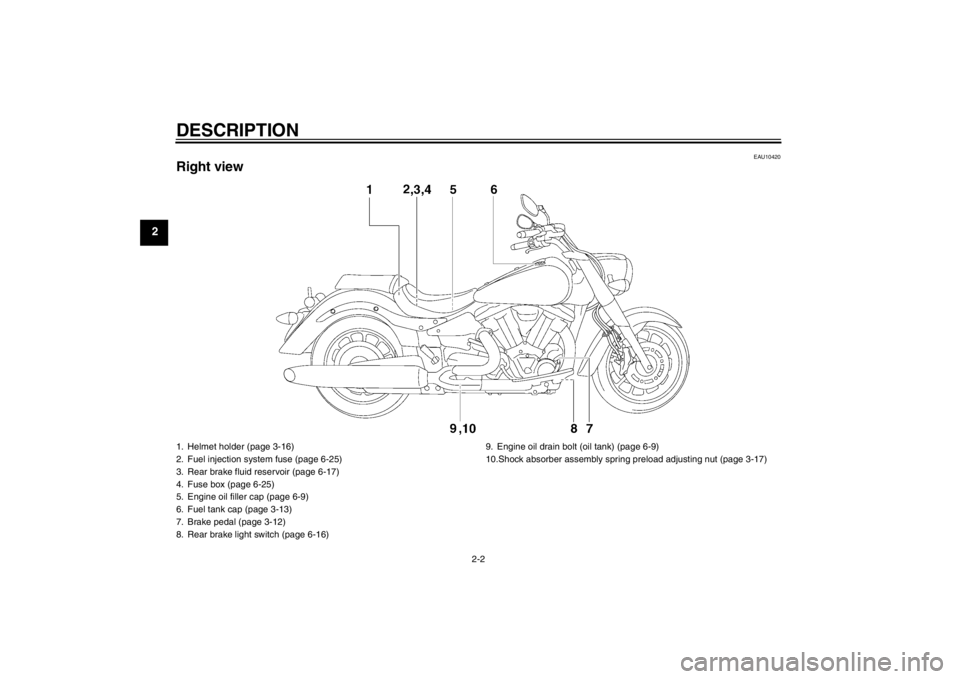
DESCRIPTION
2-2
2
EAU10420
Right view1. Helmet holder (page 3-16)
2. Fuel injection system fuse (page 6-25)
3. Rear brake fluid reservoir (page 6-17)
4. Fuse box (page 6-25)
5. Engine oil filler cap (page 6-9)
6. Fuel tank cap (page 3-13)
7. Brake pedal (page 3-12)
8. Rear brake light switch (page 6-16)9. Engine oil drain bolt (oil tank) (page 6-9)
10.Shock absorber assembly sp
ring preload adjusting nut (page 3-17)U1CRE2E0.book Page 2 Monday, September 17, 2012 9:05 AM
Page 15 of 88
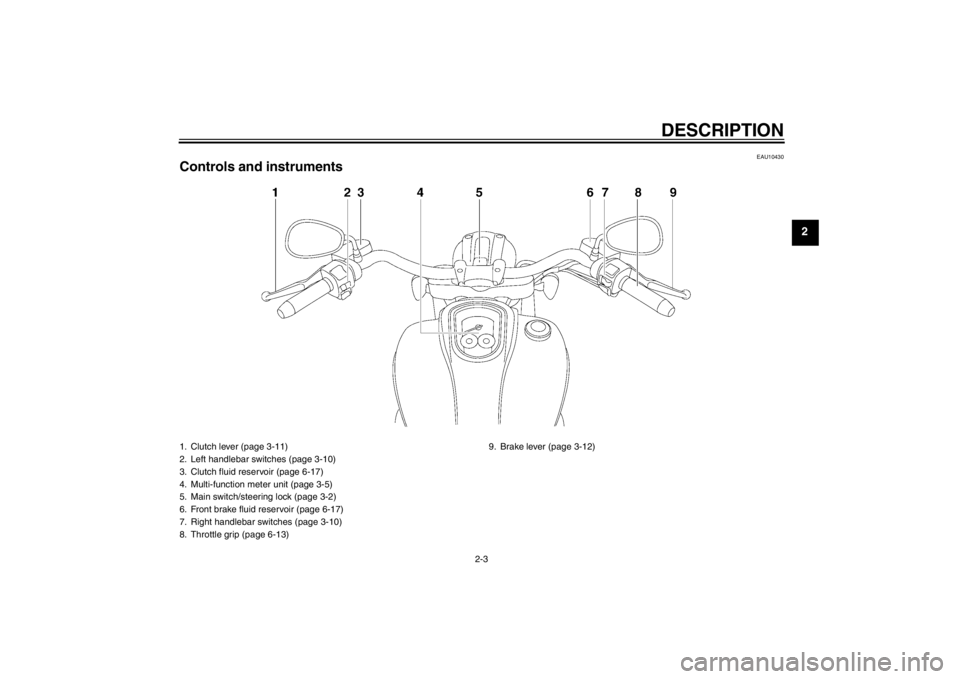
DESCRIPTION
2-3
2
EAU10430
Controls and instruments1. Clutch lever (page 3-11)
2. Left handlebar switches (page 3-10)
3. Clutch fluid reservoir (page 6-17)
4. Multi-function meter unit (page 3-5)
5. Main switch/steering lock (page 3-2)
6. Front brake fluid reservoir (page 6-17)
7. Right handlebar switches (page 3-10)
8. Throttle grip (page 6-13)9. Brake lever (page 3-12)
U1CRE2E0.book Page 3 Monday, September 17, 2012 9:05 AM
Page 16 of 88
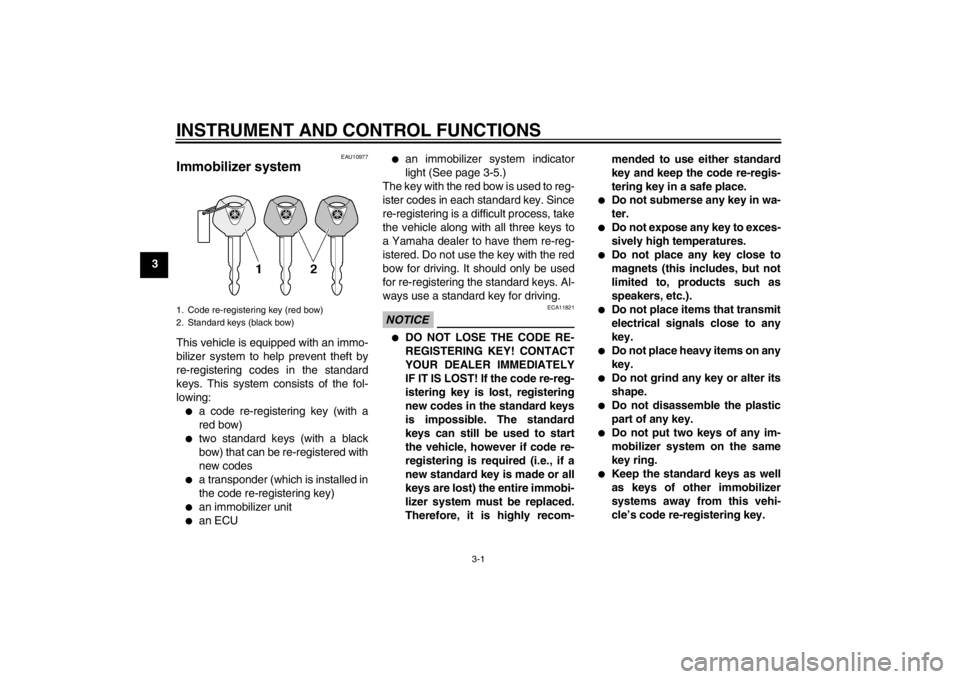
INSTRUMENT AND CONTROL FUNCTIONS
3-1
3
EAU10977
Immobilizer system This vehicle is equipped with an immo-
bilizer system to help prevent theft by
re-registering codes in the standard
keys. This system consists of the fol-
lowing:●
a code re-registering key (with a
red bow)
●
two standard keys (with a black
bow) that can be re-registered with
new codes
●
a transponder (which is installed in
the code re-registering key)
●
an immobilizer unit
●
an ECU
●
an immobilizer system indicator
light (See page 3-5.)
The key with the red bow is used to reg-
ister codes in each standard key. Since
re-registering is a difficult process, take
the vehicle along with all three keys to
a Yamaha dealer to have them re-reg-
istered. Do not use the key with the red
bow for driving. It should only be used
for re-registering the standard keys. Al-
ways use a standard key for driving.
NOTICE
ECA11821
●
DO NOT LOSE THE CODE RE-
REGISTERING KEY! CONTACT
YOUR DEALER IMMEDIATELY
IF IT IS LOST! If the code re-reg-
istering key is lost, registering
new codes in the standard keys
is impossible. The standard
keys can still be used to start
the vehicle, however if code re-
registering is required (i.e., if a
new standard key is made or all
keys are lost) the entire immobi-
lizer system must be replaced.
Therefore, it is highly recom- mended to use either standard
key and keep the code re-regis-
tering key in a safe place.
●
Do not submerse any key in wa-
ter.
●
Do not expose any key to exces-
sively high temperatures.
●
Do not place any key close to
magnets (this includes, but not
limited to, products such as
speakers, etc.).
●
Do not place items that transmit
electrical signals close to any
key.
●
Do not place heavy items on any
key.
●
Do not grind any key or alter its
shape.
●
Do not disassemble the plastic
part of any key.
●
Do not put two keys of any im-
mobilizer system on the same
key ring.
●
Keep the standard keys as well
as keys of other immobilizer
systems away from this vehi-
cle’s code re-registering key.
1. Code re-registering key (red bow)
2. Standard keys (black bow)U1CRE2E0.book Page 1 Monday, September 17, 2012 9:05 AM
Page 17 of 88
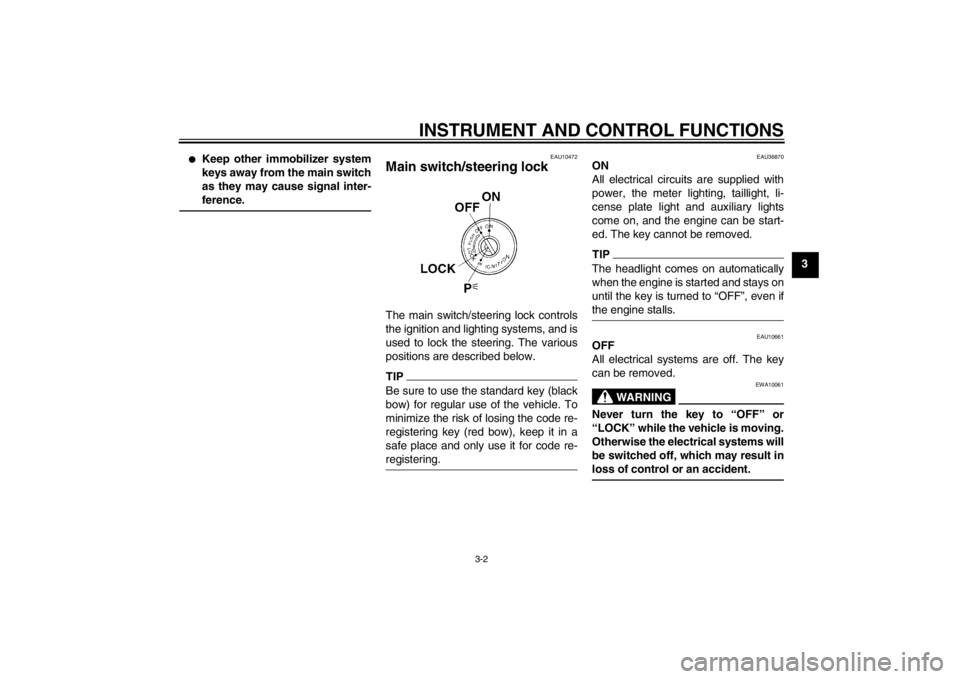
INSTRUMENT AND CONTROL FUNCTIONS
3-2
3
●
Keep other immobilizer system
keys away from the main switch
as they may cause signal inter-
ference.
EAU10472
Main switch/steering lock The main switch/steering lock controls
the ignition and lighting systems, and is
used to lock the steering. The various
positions are described below.TIPBe sure to use the standard key (black
bow) for regular use of the vehicle. To
minimize the risk of losing the code re-
registering key (red bow), keep it in a
safe place and only use it for code re-
registering.
EAU36870
ON
All electrical circuits are supplied with
power, the meter lighting, taillight, li-
cense plate light and auxiliary lights
come on, and the engine can be start-
ed. The key cannot be removed.TIPThe headlight comes on automatically
when the engine is started and stays on
until the key is turned to “OFF”, even if
the engine stalls.
EAU10661
OFF
All electrical systems are off. The key
can be removed.
WARNING
EWA10061
Never turn the key to “OFF” or
“LOCK” while the vehicle is moving.
Otherwise the electrical systems will
be switched off, which may result in
loss of control or an accident.
U1CRE2E0.book Page 2 Monday, September 17, 2012 9:05 AM
Page 18 of 88

INSTRUMENT AND CONTROL FUNCTIONS
3-3
3
EAU10684
LOCK
The steering is locked, and all electrical
systems are off. The key can be re-
moved.
To lock the steering1. Turn the handlebars all the way tothe left.
2. Push the key in from the “OFF” po- sition, and then turn it to “LOCK”
while still pushing it.
3. Remove the key. To unlock the steering
Push the key in, and then turn it to
“OFF” while still pushing it.
EAU10941
(Parking)
The steering is locked, and the taillight,
license plate light and auxiliary lights
are on. The hazard lights and turn sig-
nal lights can be turned on, but all other
electrical systems are off. The key can
be removed.
The steering must be locked before the
key can be turned to “ ”.
NOTICE
ECA11020
Do not use the parking position for
an extended length of time, other-
wise the battery may discharge.
1. Push.
2. Turn.12
1. Push.
2. Turn.12
U1CRE2E0.book Page 3 Monday, September 17, 2012 9:05 AM
Page 19 of 88
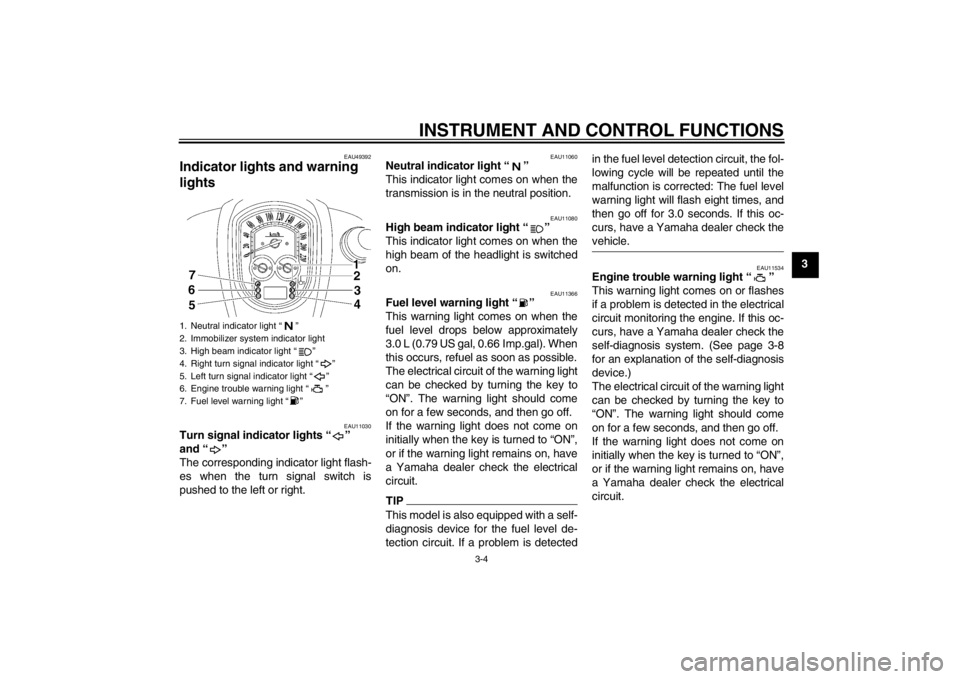
INSTRUMENT AND CONTROL FUNCTIONS
3-4
3
EAU49392
Indicator lights and warning
lights
EAU11030
Turn signal indicator lights “ ”
and “ ”
The corresponding indicator light flash-
es when the turn signal switch is
pushed to the left or right.
EAU11060
Neutral indicator light “ ”
This indicator light comes on when the
transmission is in the neutral position.
EAU11080
High beam indicator light “ ”
This indicator light comes on when the
high beam of the headlight is switched
on.
EAU11366
Fuel level warning light “ ”
This warning light comes on when the
fuel level drops below approximately
3.0 L (0.79 US gal, 0.66 Imp.gal). When
this occurs, refuel as soon as possible.
The electrical circuit of the warning light
can be checked by turning the key to
“ON”. The warning light should come
on for a few seconds, and then go off.
If the warning light does not come on
initially when the key is turned to “ON”,
or if the warning light remains on, have
a Yamaha dealer check the electrical
circuit.TIPThis model is also equipped with a self-
diagnosis device for the fuel level de-
tection circuit. If a problem is detectedin the fuel level detection circuit, the fol-
lowing cycle will be repeated until the
malfunction is corrected: The fuel level
warning light will flash eight times, and
then go off for 3.0 seconds. If this oc-
curs, have a Yamaha dealer check the
vehicle.
EAU11534
Engine trouble warning light “ ”
This warning light comes on or flashes
if a problem is detected in the electrical
circuit monitoring the engine. If this oc-
curs, have a Yamaha dealer check the
self-diagnosis system. (See page 3-8
for an explanation of the self-diagnosis
device.)
The electrical circuit of the warning light
can be checked by turning the key to
“ON”. The warning light should come
on for a few seconds, and then go off.
If the warning light does not come on
initially when the key is turned to “ON”,
or if the warning light remains on, have
a Yamaha dealer check the electrical
circuit.
1. Neutral indicator light “ ”
2. Immobilizer system indicator light
3. High beam indicator light “ ”
4. Right turn signal indicator light “ ”
5. Left turn signal indicator light “ ”
6. Engine trouble warning light “ ”
7. Fuel level warning light “ ”
U1CRE2E0.book Page 4 Monday, September 17, 2012 9:05 AM
Page 20 of 88
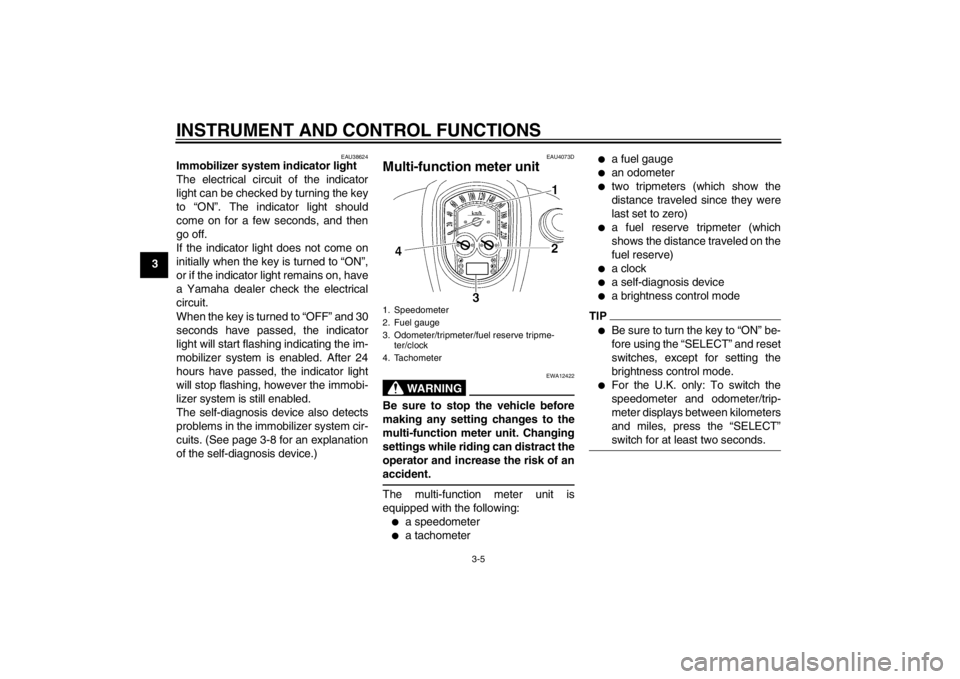
INSTRUMENT AND CONTROL FUNCTIONS
3-5
3
EAU38624
Immobilizer system indicator light
The electrical circuit of the indicator
light can be checked by turning the key
to “ON”. The indicator light should
come on for a few seconds, and then
go off.
If the indicator light does not come on
initially when the key is turned to “ON”,
or if the indicator light remains on, have
a Yamaha dealer check the electrical
circuit.
When the key is turned to “OFF” and 30
seconds have passed, the indicator
light will start flashing indicating the im-
mobilizer system is enabled. After 24
hours have passed, the indicator light
will stop flashing, however the immobi-
lizer system is still enabled.
The self-diagnosis device also detects
problems in the immobilizer system cir-
cuits. (See page 3-8 for an explanation
of the self-diagnosis device.)
EAU4073D
Multi-function meter unit
WARNING
EWA12422
Be sure to stop the vehicle before
making any setting changes to the
multi-function meter unit. Changing
settings while riding can distract the
operator and increase the risk of an
accident.The multi-function meter unit is
equipped with the following:●
a speedometer
●
a tachometer
●
a fuel gauge
●
an odometer
●
two tripmeters (which show the
distance traveled since they were
last set to zero)
●
a fuel reserve tripmeter (which
shows the distance traveled on the
fuel reserve)
●
a clock
●
a self-diagnosis device
●
a brightness control mode
TIP●
Be sure to turn the key to “ON” be-
fore using the “SELECT” and reset
switches, except for setting the
brightness control mode.
●
For the U.K. only: To switch the
speedometer and odometer/trip-
meter displays between kilometers
and miles, press the “SELECT”
switch for at least two seconds.
1. Speedometer
2. Fuel gauge
3. Odometer/tripmeter/fuel reserve tripme-ter/clock
4. Tachometer
U1CRE2E0.book Page 5 Monday, September 17, 2012 9:05 AM